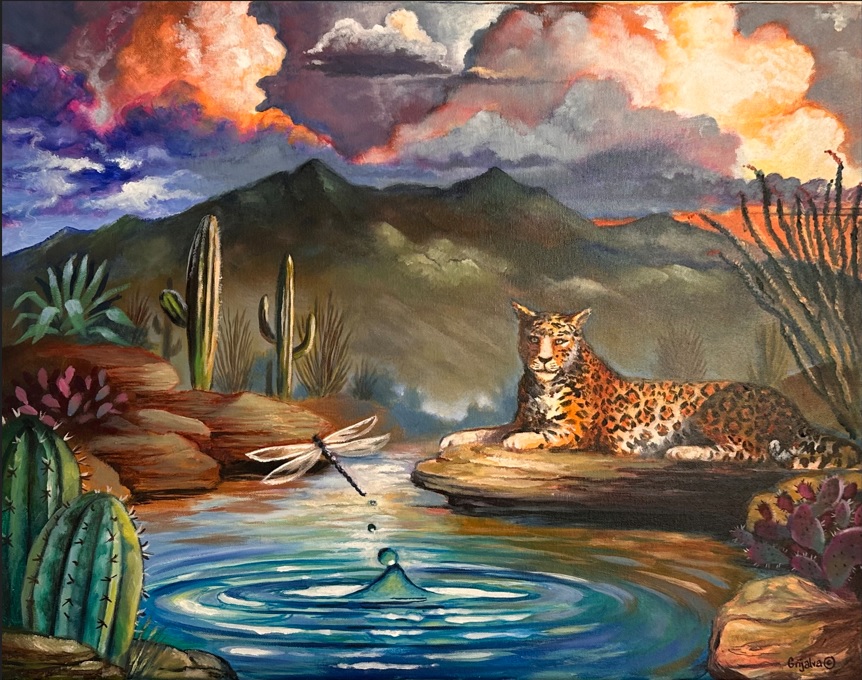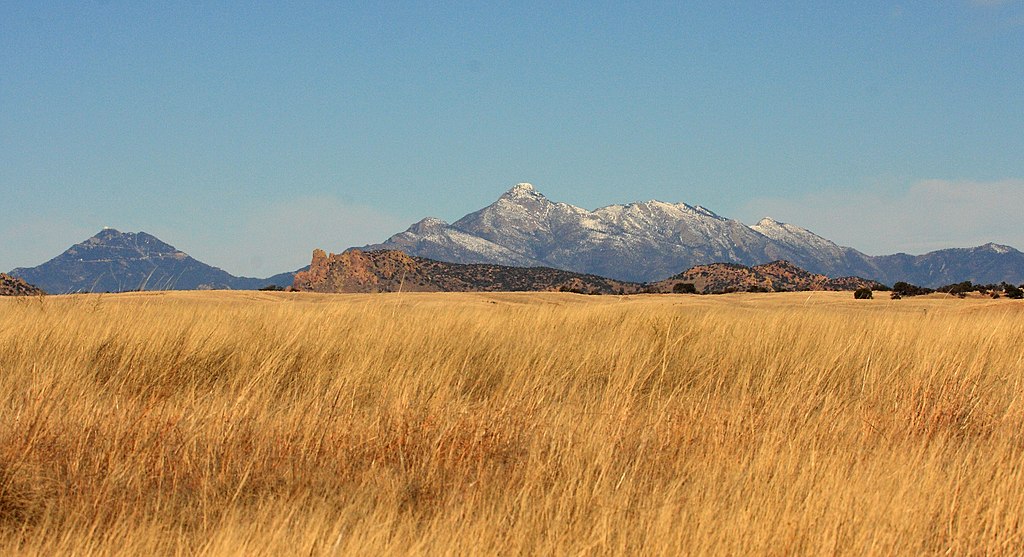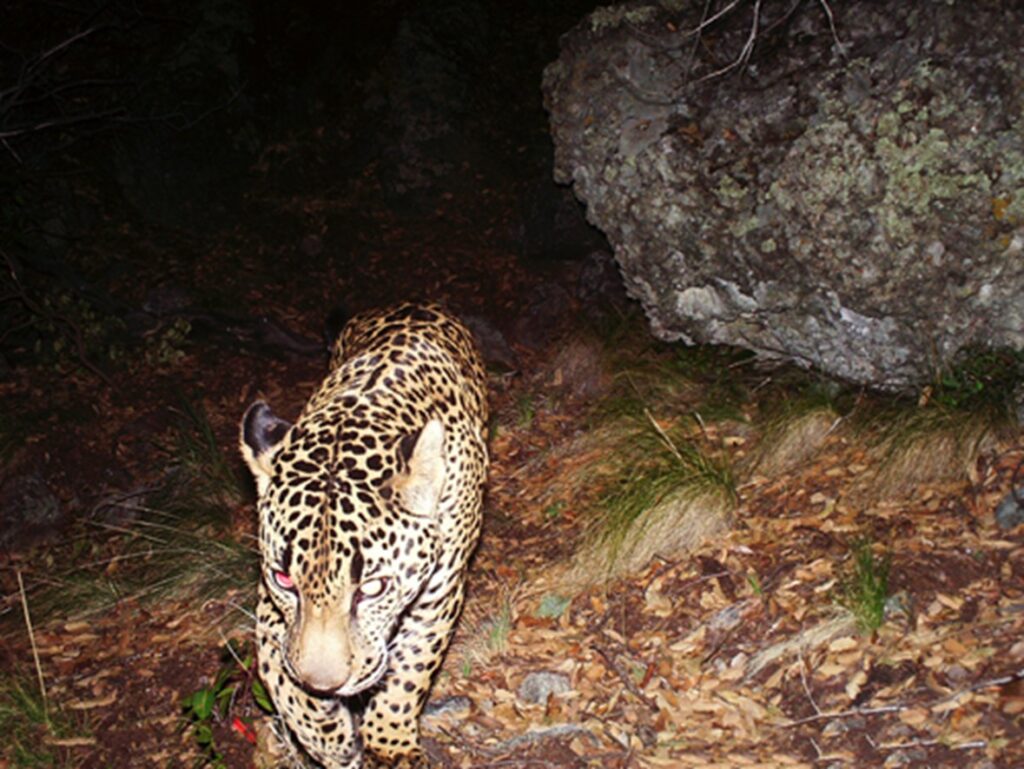
Jaguar Borderlands: Santa Cruz County
Miguel Grijalva (2024), Oil on Canvas
Arizona-Sonora Borderland Rare and Endangered Species
Cholla Rose Duir
Key Concepts and Geology
- Umbrella Species are species selected for making conservation-related decisions, typically because protecting these species indirectly protects the many other species that make up the ecological community of their habitat (the umbrella effect). The jaguar is an umbrella species with its large territories (75 square miles or more).
- Sky Islands are isolated mountain ranges in southeastern Arizona and northern Mexico. Some of the mountains rise more than 6,000 feet above the surrounding desert floor, making the lowlands and high peaks drastically different. Plants and animals living in the mountains could never survive in the surrounding deserts.
- Jaguars are a threatened species with numbers in decline worldwide and are the largest cat species in the Americas; Santa Cruz County and the rest of Southern Arizona are now the northern limit of the jaguar’s habitat
- Jaguars have always lived in Arizona and were extirpated along with many other predators to allow for cattle grazing under a false narrative that the two could not exist simultaneously. The last female jaguar in Arizona was killed in the 1960s; all of Arizona’s currently documented jaguars are males, most likely born in Sonora, Mexico
- Cross-border conservation efforts are necessary to protect the jaguars’ home in Southern Arizona
Key Terms and Translations
- Libélula – Spanish for dragonfly
- Primas- Spanish for cousin (feminine)
- Hijos-Spanish for sons
- Madre-Spanish for mother
- Hermanos-Spanish for brother
- Rio Aros-Mexico’s longest undammed river, located entirely within the State of Sonora
- Spot Pattern Analysis is used to identify one jaguar from another by comparing their unique spot patterns.
- Wildlife Corridor- a known tract of land that connects populations of wildlife otherwise separated by human development.
- Wildlife Crossing– a human-constructed passageway, such as an overpass or underpass, allowing wildlife to cross roadways or other human developments safely
- Wildlife Connectivity– the larger process of unimpeded wildlife movement that sustains viable and healthy populations in the long term.
- Protected Areas– areas where humans have set aside land for wildlife or are practicing cohabitation strategies to coexist.
- Non–Invasive Wildlife Study– studying wildlife without disrupting their normal patterns or physical health. For example, the use of trail cameras or ethical tracking practices.
A3. Special Focus A: How do Jaguars Live in Santa Cruz County?
Arizona-Sonora Borderland Rare and Endangered Species
Cholla Rose Duir

Macho B wearing a collar in Santa Cruz County’s Atascosa Mountains in 2009. Photo provided by the Arizona Game and Fish Department.
Jaguar Journeys in Santa Cruz County
Libélula the jaguar sat near a pool of water. The female jaguar watched her namesake, the dragonfly, skip over the water and dance into the air. She should have been content, having just had a meal of javelina on a warm spring day, yet she was restless and full of anticipation. Libélula was expecting the birth of a cub, and this one felt different. She was unsure why, but she couldn’t shake the feeling that this cub was destined for something exceptional. Libélula had raised two previous cubs in her lifetime, which was no small feat for a wild jaguar living at the northernmost extent of their range in the Sonoran Desert, where food could be scarce during frequent periods of drought. She patrolled a vast territory (75 square miles) that overlapped with several other female and male jaguars. She was a small jaguar, around 100 pounds, as they tend to be in the northern ranges, as opposed to the jaguars of the Amazon, who top out at around 250 pounds. However, her small size was no indication of weakness. She was a survivor, a mother, a hunter, and one of the last of her kind.
Libélula could not remember her birthplace, but it was likely close to where she now lived, as females tend to stay close to home, unlike males who enjoy wandering hundreds of miles to find new territories and father cubs. Libélula’s home was one of much beauty about 120 miles south of the US-Mexico border and along the Rio Aros, Mexico’s longest undammed river. Libélula had been told stories of other lands where human neighbors could be brutal and kill jaguars for their coats or for getting too close to their livestock. This place was different, though; she had even overheard the local ranchers bragging about her beauty and resilience, referring to her as “The Queen of the Reserve.” The humans did not take her prey; in return, she did not need to take their cattle. It seemed to her they respected each other, and she felt safe in her home. Still, like most jaguars, she kept her distance from humans, unlike her primas, the Mountain lion and Bobcat, who seemed less bothered by human activity. She preferred the quiet, densely vegetated, and remote areas to the ones close to ranches or roads.

Baby Jaguar Cubs
Libélula’s deep golden eyes squinted as the morning sun found its way into the limestone cave she called home when birthing cubs. The anticipation she felt before was gone as she groomed her two new cubs. Multiple cubs are not unheard of in the jaguar familia, but this was Libélula’s first time having more than one cub, and she was overcome by the presence of so many heartbeats in her normally quiet den. She now knew why she felt so restless. This would be a new experience for sure. Born with their eyes and ears closed (for the first 10-14 days), jaguar cubs enter the world completely dependent on their mother for survival and remain reliant on her care and guidance for approximately two years. Libélula still sensed something different in the air about these two hermanos. Like thunder from a distant storm, she felt excitement and fear of the unknown brewing in their shared future.
The cubs grew quickly and soon began to show their individual personalities. Like all jaguars, they also had unique spot patterns, similar to human fingerprints; no two were the same. Libélula began calling them El Jefe and Macho B. Names chosen for her hijos to honor the strength she saw building between them. They did everything together, and as their second birthday approached, Libélula prepared herself to say goodbye so they could also seek out their own territories. Their separation from each other was also inevitable as jaguars prefer a mostly solitary life, but perhaps their territories would always overlap. Only time will tell; one thing was certain: a journey for both of them was coming soon.
Jaguar Journeys Across the Border
Libélula prepared El Jefe and Macho B for their journey by telling them grand stories of the landscapes surrounding them to the north and south. In both directions, there would be great challenges of broken ecosystems crisscrossed with human roads and development and barren, overused landscapes, excessively hot with little prey or water to sustain them. Their best chance was to stick close to the Sky Islands, a range of mountains connecting the Sierra Madre of Mexico to the Rocky Mountains of the United States. The mountains were islands of protection, life, and water separated by seas of desert.

El Jefe has been spotted many times in Santa Cruz County’s Santa Rita Mountains, one of the Sky Island ranges of Southern Arizona. Image Source: Wikipedia.
El Jefe and Macho B said their tearful goodbyes. They chose to head north, intrigued by their madre’s stories of vast unclaimed northern territories and the diversity of prey from lowland deserts to the high peaks of the mountains in the Sky Islands in Southern Arizona. Libélula secretly wished they had chosen the southern path with more jaguars and tropical vegetation in Mexico. Still, she knew in her heart that her hijos were destined for something bigger, a story she could feel was beyond her grasp but vital to their survival.
The journey north had been mostly uneventful, apart from frequent squabbles over sharing meals, which inevitably ended with two mostly full bellies. That is until Macho and El Jefe came across a vast cleared area, a road of sorts. This differed from the small dusty dirt roads they were accustomed to seeing in their madre’s territory. This road was black and hot and smelled of the burning sun. They kept a good distance and turned back twice, afraid to touch the foreign material and wary of the cars that speed by frequently. Staying hidden for days, they finally decided to make a run to cross it in the dead of night. Their paws had never touched asphalt before, and the warmth still radiated off the blacktop, soaking into their skin as they sped across. They kept running long after leaving the road behind until, once again, a new barrier, this one even more formidable, stood between them and what they both desperately needed: water. The hermanos had managed to have successful hunts, but finding water had eluded them for days, much longer without it, and they would succumb to thirst.
El Jefe was the first to see the wall. At first, he thought it must have been a vast canyon in the distance, but as they got closer, he smelled human presence and saw lights along the edges. Macho B began to turn back, but his hermano urged him to continue on to investigate what the humans were doing. It was nighttime, after all, and they knew how to stay hidden, soundlessly approaching from downwind. Four humans huddled close to the wall; they smelled of nervousness and fear, yet there was also an air of excitement and urgency. Whatever they were doing, it was in a hurry. They held a burning blue fire up the wall base, and soon, it became apparent that they had cut a hole just wide enough to slip through. One by one, the humans slipped through and ran quickly once on the other side. Little did they know they had just saved the lives of two thirsty jaguars who followed suit once the path was clear.
Macho B and El Jefe had crossed from what humans call Mexico and northern Sonora into the United States of America and southern Arizona. Of course, this held no meaning to them. They only knew of the mountains and streams, with no hard borders, just gentle changes into something new. They would roam this portion of the Sky Islands for many years, learning to find sanctuary in protected areas with abundant prey and clean water that flowed from mountain springs and was provided by stock tanks or wildlife drinking areas. They also learned to avoid roads, fences, walls, and orange water seeping from long-abandoned mines that burned their tongues soon, though danger would find them, changing their peaceful existence forever.
El Jefe and Macho B in the Sky Islands

Miguel Grijalva (2024), Oil on Canvas
Macho B awoke to the sounds of dawn in the pine forest mountaintop near Nogales, Arizona. The birds chirping in the distance and the bubbling stream near his den lulled him back to sleep for a fleeting moment. Being most active during dawn and dusk, this was one of Macho’s favorite hunting times, and he decided to rise to the occasion, stretching his now aging back one vertebra at a time. A huge yawn was also needed to prepare the most powerful jaws of the feline family for the potential of a successful white-tailed deer hunt, Macho’s favorite breakfast. Macho B had now lived in his territory for over ten years, learning to navigate, hunt, and love the place the humans called Santa Cruz County.
Like his hermano, El Jefe found his own territory in Santa Cruz County, though he preferred the high peaks of the Santa Rita Mountains and the taste of javelina over white-tailed deer. A light dusting of February snow had fallen the night before, and El Jefe licked the cold moister from his paws, contemplating his next move. He felt a sense of unease and the need to travel back south, and as one who enjoyed wondering, he began to walk along the treeline, knowing his madre and path back home was calling. El Jefe also longed for a familia of his own; he didn’t know of any female jaguars in the area. He had looked for a long time. Being a male jaguar, he did not question the wisdom of the female jaguars to remain south as they knew best where to raise cubs on their own. He would have to travel there and meet them on their terms, so his journey began.
Macho B’s Journey in Santa Cruz County
El Jefe crossed into Macho B’s territory just south of his – the wild Atascosa Mountains west of Nogales. Now that they were grown, he and his brother went long stretches without seeing each other, but they never forgot sharing meals together as cubs, so their encounters were friendly. El Jefe saw the claw marks Macho B left to mark his territory, but scent and scat marks seemed oddly faint, like Macho B had not been around for a day or so. As El Jefe approached a small bluff, he suddenly saw why. Below him lay Macho B with his paw caught tightly in a metal snare. El Jefe quickly ran to free him, but as he approached, he heard humans in the distance and knew he would only have seconds to say goodbye. Macho B and El Jefe snuffled at each other, a sign of reassurance. Words were not spoken because a deep understanding was already there. They had survived together long enough to understand that humans, when determined, had an unfair advantage over other animals, and it was better that one of them survive than to try and fight and die together.
As the humans rounded the corner, El Jefe disappeared into the brush, and Macho B prepared for the inevitable. Macho B was surprised when the humans did not immediately shoot him like he had seen happen to other animals caught in snares. They seemed to be contemplating something and in awe of his presence. Little did Macho B know that these humans had been watching him for 13 years. Macho B was the first jaguar officially documented in many decades as a resident jaguar of the U.S., not just a jaguar passing through, but a jaguar making a home and thriving in the Arizona wilderness. Much of Macho B’s adult life took place around Santa Cruz County’s mountain ranges.
Then the humans raised a gun, and Macho winced as a dart pierced the skin of his hind end. He slipped into unconsciousness. Many cultures believe cats can walk between worlds, being comfortable both during the day and night and in the world of the living and the dead. For the next twelve days, Macho B would walk between worlds, never fully returning to the world of the living, passing away at the hands of a veterinarian through euthanasia at a place called the Phoenix Zoo on March 2, 2009. Macho B’s death crushed the hearts of many humans who had grown to love him. At the time, Macho B was the only known wild jaguar living in the United States. Macho’s life and death remain pivotal moments in understanding how to protect jaguars.
Conclusion: Jaguars and Cross-Border Conservation
El Jefe knew his hermano had passed. He felt his presence traveling alongside him as he returned home to Mexico and found peace, knowing he was no longer trapped. Those first drinks of the cool water running through the Rio Aros flowed through his body, filling him with joy as he knew he would soon see his madre. El Jefe and Libélula’s reunion exchanged the silent knowing of love held between familia no matter the circumstances. Libélula was now quite old and ready to pass on and join Macho B, walking between worlds. Humans who loved her would later find her remains and easily identify her as her spots still remained. Perhaps El Jefe’s parting gift to his madre was to protect her body from scavengers.”
El Jefe would travel on and find solace in another protected area in Mexico, fathering many cubs. He never knew the inspiration and joy his jaguar familia’s life and journey brought to his many human fans who still await his mysterious story’s conclusion. Until Next Time…
***Macho B, El Jefe, and Libélula are all real, officially documented jaguars. This story and their relationships with each other are purely fictional for the purposes of storytelling and education. Although whenever possible, elements of truth known about each jaguar’s life were included***
Brief Descriptions of Macho B, Libélula, and El Jefe
Macho B was first documented by Jack Childs, a local hunter, in 1996 in the Baboquivari Mountains. He was the first wild jaguar seen in Arizona in nearly 30 years. Over the next 13 years, trail cameras documented Macho B many times. On February 18th, 2009, the Arizona Game and Fish Department captured him in a leg snare in a canyon west of Nogales, Arizona. Macho B was fitted with a radio collar but, unfortunately, never fully recovered from being captured and sedated. He was euthanized 12 days later on March 2. Macho B’s well-documented life was proof that jaguars can still survive in the wildlands of Arizona, living side by side with ranchers and hunters who showed him kindness and rekindling stories long forgotten when jaguars roamed as far north as the Grand Canyon.
Macho B’s death highlights the risks associated with invasive wildlife study practices such as trapping, sedating, and collaring animals. When so few individuals are left, these measures are best avoided for more noninvasive study practices, such as ethical tracking, in which animals are tracked in a manner that does not cause them to flee or experience stress, or through the use of technology such as wildlife trail cameras and the collection and study of feces. Additionally, it is equally important to seek knowledge on wildlife from sources outside of academia in local traditions and storytelling, which can lead to valuable insights without endangering the lives of wildlife and, at the same time, enrich the bigger picture of how humans and animals relate to each other and their shared environments.

2009 Photo provided by the Arizona Game and Fish Department – Photo by Robin Silver/AP of Macho B
Libélula was first documented in April 2012 in the Northern Jaguar Reserve in Sonora, Mexico. Libélula was documented for the next 11 years, raising at least 2 cubs. Libélula lived her life in a protected area, moving between a wildlife reserve and 19 partner ranches that participate in a program called Viviendo con Felinos ® in which the ranchers are compensated for trail camera images of wild cats in exchange for not killing them or their prey. Libélula passed away of natural causes in late 2023 and was estimated to be at least 13 years old. Her life was a testament to how cohabitation practices allow ranching and jaguars to live side by side.

2021 Photo provided by Northern Jaguar Project – taken by a wildlife trail camera of Libélula (back) and cub (front)
El Jefe was first documented in November 2011 in the Whetstone Mountains. Over several years, he was also documented roaming the Santa Rita Mountains. He mysteriously disappeared from the cameras after the fall of 2015 and reappeared in 2021 in central Sonora, Mexico. El Jefe was the first jaguar to be documented after the death of Macho B. El Jefe’s long journey highlights the need for protected wildlife corridors, crossings, and connectivity of protected places in Santa Cruz County and the Arizona-Sonora border.

Photo of El Jefe in the Santa Rita Mountains, in 2015. Photo credit: University of Arizona Jaguar and Ocelot Monitoring Team
Bibliography
- Brown, David E., and Carlos A. Lopez Gonzalez. Borderland Jaguars = Tigres de La Frontera. University of Utah Press, 2001.
- ICUN Jaguar
- Mahler, Richard. The Jaguar’s Shadow: Searching for a Mythic Cat. New Haven, CT: Yale University Press, 2009.
- Eisenberg, Cristina. The Carnivore Way: Coexisting with and Conserving North America’s Predators. Washington, D.C.: Island Press, 2015.
- Rabinowitz, Alan. An Indomitable Beast: The Remarkable Journey of the Jaguar. Washington, D.C.: Island Press/Center for Resource Economics, 2014.
- US Fish and Wildlife Service: Jaguar
- Jaguar Observations Database – Map of sightings
- USFWS Jaguar Recovery Plan-Great source of information and maps of both the U.S. and Mexico jaguar habitat
- University of Arizona – Wildcat Research and Conservation
